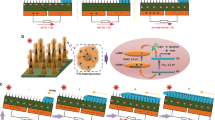Abstract
Triboelectric nanogenerators (TENGs) are gaining attention for energy supply because of higher demands in decentralized energy production. TENGs are known for being self-energy harvesters, converting wasted mechanical energy to useful electrical energy under an ambient environment. Advantages of TENGs include a clean energy supply, a wide range of materials selection, and an energy scavenging capability in the ambient environment. However, TENGs still suffer from their low electrical outputs compared to existing electrical supplies such as fuel cells and batteries. In bio-photovoltaic (BPV), there has been an interest in the use of microalgae, which are photosynthetic microorganisms capable of carbon capture and generating bioelectricity both day and night through electron transport chains via photosynthesis and cell respiration. To increase the current output of BPV, many have tried to immobilize living microalgal cells onto electrodes for higher mass transfers leading to higher photosynthetic rates. In this study, we have used immobilized living microalgae (Chlorella sp.) onto aluminium sheets to fabricate the TENG systems and investigate biomechanical energy harvesting. This proof of concept shows that this integration of microalgae with TENG can enhance the voltage and current output achieved by the dual operation modes of TENG. One issue raised during the tests was maintaining microalgae alive for several days, which has given opportunities for further studies in nutrient and light supplies to this innovative sustainable hybrid technology. The results confirm that the microalgae can be an excellent triboelectric layer in TENG for biomechanical energy harvesting.
Graphical Abstract







Similar content being viewed by others
References
Joselin Herbert, G.M., et al.: A review of wind energy technologies. Renew. Sustain. Energy Rev. 11(6), 1117–1145 (2007)
Kannan, N., Vakeesan, D.: Solar energy for future world: - a review. Renew. Sustain. Energy Rev. 62, 1092–1105 (2016)
Zhang, S.S.: Liquid electrolyte lithium/sulfur battery: fundamental chemistry, problems, and solutions. J. Power Sources. 231, 153–162 (2013)
Wang, Z.L.: Triboelectric nanogenerator (TENG)—sparking an energy and sensor revolution. Adv. Energy Mater. 10(17). (2020). https://doi.org/10.1002/aenm.202000137
Hajra, S., et al.: A green metal–organic framework-cyclodextrin MOF: a novel multifunctional material based triboelectric nanogenerator for highly efficient mechanical energy harvesting. Adv. Funct. Mater., 31(28) (2021). https://doi.org/10.1002/adfm.202101829
Hajra, S., et al.: Lead-free flexible bismuth titanate-PDMS composites: a multifunctional colossal dielectric material for hybrid piezo-triboelectric nanogenerator to sustainably power portable electronics. Nano Energy, 89 (2021). https://doi.org/10.1016/j.nanoen.2021.106316
Panda, S., et al.: Piezoelectric energy harvesting systems for biomedical applications. Nano Energy, 100 (2022). https://doi.org/10.1016/j.nanoen.2022.107514
Glynne-Jones, P., et al.: An electromagnetic, vibration-powered generator for intelligent sensor systems. Sens. Actuators A: Phys. 110(1–3), 344–349 (2004)
Huo, Z.Y., et al.: Triboelectrification induced self-powered microbial disinfection using nanowire-enhanced localized electric field. Nat. Commun. 12(1), 3693 (2021)
Tat, T., et al.: Advances in triboelectric nanogenerators for biomedical sensing. Biosens. Bioelectron. 171, 112714 (2021)
Ding, W., et al.: TriboPump: a low-cost, hand‐powered water disinfection system. Adv. Energy Mater. 9(27). (2019). https://doi.org/10.1002/aenm.201901320
Peng, K.T., et al.: Recent progress in solar-induced direct Biomass-to-electricity hybrid fuel cell using Microalgae as Feedstocks. Front. Bioeng. Biotechnol. 9, 638971 (2021)
Wey, L.T., et al.: The development of Biophotovoltaic Systems for Power Generation and Biological Analysis. ChemElectroChem. 6(21), 5375–5386 (2019)
Gouveia, L., et al.: Effect of light on the production of bioelectricity and added-value microalgae biomass in a photosynthetic Alga Microbial fuel cell. Bioresour Technol. 154, 171–177 (2014)
Kaushik, S., Sarma, M.K., Goswami, P.: FRET-guided surging of cyanobacterial photosystems improves and stabilizes current in photosynthetic microbial fuel cell. J. Mater. Chem. A. 5(17), 7885–7895 (2017)
In-na, P., et al.: Loofah-based microalgae and cyanobacteria biocomposites for intensifying carbon dioxide capture.Journal of CO2 Utilization, 42. (2020). https://doi.org/10.1016/j.jcou.2020.101348
Renger, G.: Mechanism of light induced water splitting in Photosystem II of oxygen evolving photosynthetic organisms. Biochim. Biophys. Acta. 1817(8), 1164–1176 (2012)
Ahmad, M., Wolberg, A., Kahwaji, C.I.: Biochemistry, Electron Transport Chain. StatPearls Publishing (2021)
Tschortner, J., Lai, B., Kromer, J.O.: Biophotovoltaics: green power generation from sunlight and water. Front. Microbiol. 10, 866 (2019)
Acknowledgements
This study is supported by the Basic Science Research Program through the National Research Foundation of Korea (NRF), funded by the Ministry of Science and ICT of Korea (2021R1C1C1011588) and DGIST R&D program (22-HRHR-05). The authors would like to thank Dr. Nattapon Pombubpa from the Department of Microbiology, Faculty of Science, Chulalongkorn University for his laboratory facility, where the research work was conducted.
Author information
Authors and Affiliations
Contributions
SH: Conceptualization, Writing-Original Draft, Formal Analysis; PI: Conceptualization, Writing-Original Draft, Methodology, Supervision; CJ: Data Collection, SP: Visualization, Investigation; HJK: Writing-Review & Editing, Funding, Supervision.
Corresponding author
Ethics declarations
Conflict of interest
The authors declare no conflict of interest.
Additional information
Publisher’s Note
Springer Nature remains neutral with regard to jurisdictional claims in published maps and institutional affiliations.
Sugato Hajra and Pichaya In-na have contributed equally.
Rights and permissions
Springer Nature or its licensor (e.g. a society or other partner) holds exclusive rights to this article under a publishing agreement with the author(s) or other rightsholder(s); author self-archiving of the accepted manuscript version of this article is solely governed by the terms of such publishing agreement and applicable law.
About this article
Cite this article
Hajra, S., In-na, P., Janpum, C. et al. Triboelectric Nanogenerators Based on Immobilized Living Microalgae for Biomechanical Energy Harvesting. Electron. Mater. Lett. 19, 367–373 (2023). https://doi.org/10.1007/s13391-022-00406-z
Received:
Accepted:
Published:
Issue Date:
DOI: https://doi.org/10.1007/s13391-022-00406-z




